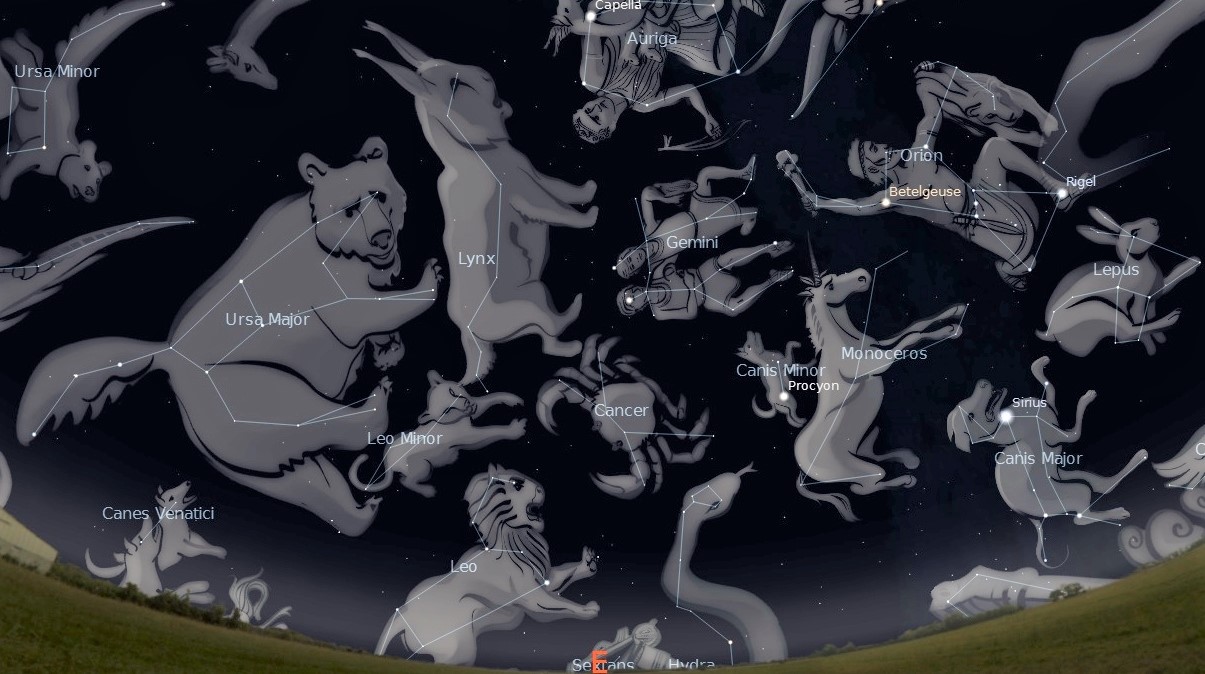This Week’s Sky at a Glance, 2020 December 26 – 2021 January 2 ~by Curt Nason
This week, check out the eastern sky around 10 pm to hunt down four dogs, three cats, two bears, a hare, a snake and a crab. Oh, and a unicorn if you believe in them.
Start looking toward the southeast where Orion is hunting. Below his feet is Lepus the Hare, staying immobile in hopes that Orion’s canine companions overlook him. Can you see the ears pointing to Rigel? Following Orion’s belt to the left brings you to sparkling Sirius at the heart of Canis Major the Big Dog, and it doesn’t take a great imagination to see a dog in this group of stars. Orion’s shoulders and head form an arrowhead that points toward bright Procyon, one of only a few visible stars in Canis Minor the Little Dog. Use your imagination to see Monoceros the Unicorn between the two dogs.
Now find the Big Dipper in the northeast. It forms the rear haunches and tail of Ursa Major the Big Bear, and from a rural area the legs and head of the bear can be seen easily. The two stars at the front of the bowl of the Dipper point northward to Polaris at the end of the handle of the Little Dipper, which is officially Ursa Minor the Little Bear. Below the handle of the Big Dipper are the two main stars and hounds of Canes Venatici the Hunting Dogs, seemingly nipping at the big bear’s butt.
Well below the bowl of the Big Dipper is Leo the Lion, recognized by the stellar backwards question mark of its chest and mane, with Regulus as its foreleg and a triangle forming its tail and hind leg. A faint triangle of stars between Leo and the Big Dipper is Leo Minor, the Little Lion. The third cat is Lynx, a faint line of stars running from Little Leo and past the front of Ursa Major. Between Regulus and Procyon is the head of Hydra the Water Snake, which will take much of the night to rise completely. And faint, crabby Cancer is above Hydra’s head. Stay warm and dry, and Happy New Year hunting.
This Week in the Solar System
Saturday’s sunrise in Moncton is at 8:00 am and sunset will occur at 4:39 pm, giving 8 hours, 39 minutes of daylight (8:02 am and 4:47 pm in Saint John). Next Saturday the Sun will rise at 8:01 am and set at 4:45 pm, giving 8 hours, 44 minutes of daylight (8:03 am and 4:53 pm in Saint John). Next Saturday morning the Earth will be at perihelion, its closest point to the Sun. Don’t put your parka away.
The Long Night Full Moon occurs near midnight Tuesday evening. I have fond memories of December full Moons hanging above the trees in the northwest at sunrise. Jupiter spends the week distancing from Saturn, and within a few weeks they will be lost in twilight so get your last looks in while you can. Telescope users might have a final view of Jupiter’s Red Spot before 6 pm on Monday. Although dimming, Mars rules over the early evening sky at its highest around 7:30. Venus has the morning sky to itself, rising 90 minutes before sunrise midweek.
With astronomy meetings and outreach activities on hold, you can watch the local Sunday Night Astronomy Show at 8 pm and view archived shows.
Questions? Contact Curt Nason.

